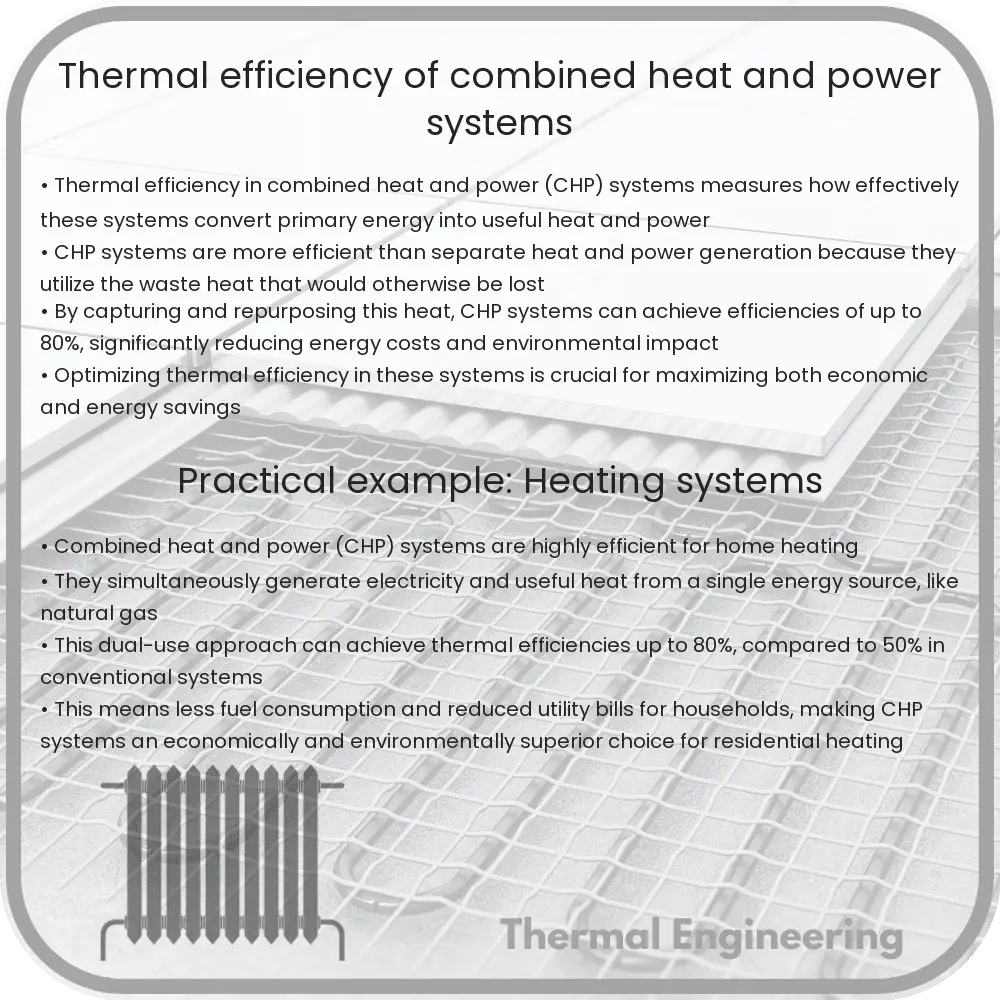Learn about thermal efficiency in Combined Heat and Power (CHP) systems, highlighting the calculation, factors influencing it, and its advantages.

Understanding Thermal Efficiency in Combined Heat and Power Systems
Combined Heat and Power (CHP), also known as cogeneration, is a highly efficient process that generates electricity and captures usable heat simultaneously. This approach is far more efficient than conventional methods of generating electricity and providing heat separately. The thermal efficiency of CHP systems is a crucial metric that signifies the effectiveness of energy utilization in this process.
What is Thermal Efficiency?
Thermal efficiency in the context of CHP systems refers to the ratio of useful energy output (both electrical and thermal) to the energy input, usually measured using fuels like natural gas or coal. The higher the thermal efficiency, the more effectively a system converts fuel into usable energy, thereby reducing waste and operating costs.
Calculation of Thermal Efficiency
The thermal efficiency (\(\eta\)) of CHP systems can be calculated using the equation:
\[ \eta = \frac{{\text{Useful heat output (Q_h) + Useful electrical output (W_e)}}}{{\text{Total fuel energy input (Q_f)}}} \times 100\% \]
Where:
- \(Q_h\) is the thermal energy produced by the system.
- \(W_e\) is the electrical energy generated.
- \(Q_f\) is the energy content of the fuel consumed.
Factors Influencing Thermal Efficiency of CHP Systems
The thermal efficiency of CHP systems is influenced by several factors, including:
- Type of fuel used: Different fuels have varying energy densities and efficiencies. Natural gas, for example, is often preferred for its higher efficiency and cleaner combustion compared to coal.
- System design: The design of the CHP system, including the technology used for both the generation of electricity and the capture of heat, significantly affects efficiency.
- Operating conditions: Operating the system within its optimal range of conditions, such as temperature and pressure, ensures maximum efficiency.
- Maintenance: Regular maintenance helps prevent the degradation of system components, which can impede efficient operation over time.
Advantages of High Thermal Efficiency in CHP Systems
Beyond the basic benefit of reduced fuel consumption, high thermal efficiency in CHP systems offers multiple advantages:
- Cost Savings: Efficient energy use translates to lower operating costs by decreasing the amount of fuel required per unit of output.
- Environmental Benefits: By maximizing the energy extracted from fuel, CHP systems lower greenhouse gas emissions and reduce the environmental footprint.
- Energy Security: Enhancing efficiency contributes to energy security by making better use of domestic fuel resources and reducing dependence on foreign energy supplies.
- Reliability: CHP systems can provide more reliable energy supply, particularly in areas susceptible to power outages, as they can be operated independently of the power grid.
In conclusion, the thermal efficiency of combined heat and power systems is a critical measure that not only reflects operational effectiveness but also impacts economic and environmental outcomes. By understanding and optimizing this efficiency, we can better harness the benefits of CHP technology, making it a cornerstone in the pursuit of sustainable energy solutions.